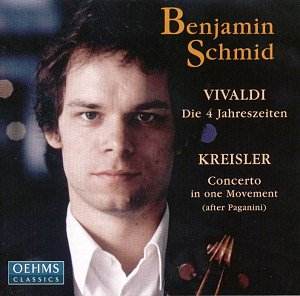Iíve come across some
weird couplings in my time but this
oneís the beeís pyjamas of weird couplings.
The rising Austrian star fiddle player
Benjamin Schmid has yoked together a
warhorse so leathery that itís barely
fit to saddle with a Kreislerian concoction
that should properly be classified under
Paganini and is, in any case, never
played. This is the arrangement, adaptation,
extrapolation (what have you) of the
first movement of the Italianís D major
Concerto, the First, though the quaint
words "after Paganini" do
serve well enough. Letís start there.
In his publicity material
it seems that Vienna hailed their returning
son as a Kreisler redivivus when
he performed there with the Philharmonic.
Which is odd. Tonally and stylistically
we know Schmid admires Ivry Gitlis,
a maverick wild card if ever there was
one, and listening to Schmidís playing
of the one movement concerto one feels
the greater pull of the contemporary
than any residual expressive features
that Kreisler may have bequeathed. That
doesnít mean of course that one demands
Schmid apes Old School devices but does
serve to show his determination to meet
a work of this kind on his own terms.
There have been very few recordings
of this work but Kreislerís own, with
the Philadelphia and Ormandy, is clearly
hors de combat and the early
post war Decca that Alfredo Campoli
made with the National Symphony Orchestra
and Victor Olof in London was profoundly
of the Kreislerian ethos Ė itís available
on Dutton but I donít like the transfer.
So maybe itís high time that a steelier,
more firmly centred and square jawed
performance was put on disc in good
sound. Certainly the orchestra commits
some forward sounding solos Ė room for
harp and a fine clarinet Ė but the focus
is on Schmid who executes his harmonics
and the tough cadenza with notable aplomb.
Of overt affection thereís perhaps less
on show.
In the Four Seasons
Schmid at least surrounds himself with
a small band, the Camerata Salzburg,
composed of fifteen strings and a harpsichord/organ
continuo. Some little orchestral swellings
in the Allegro of Autumn attest to a
concern for some influence from original
instrument performances. But in the
main these are modest, crisp chamber
orchestra sized traversals of the concerti.
There are some rather too emphatic moments
in the same concertoís slow movement
Ė and some strong ornamentation as well
Ė but Schmid digs into the opening of
Summer well and without indulgence.
His finale here is bold with roughened
articulation. He cultivates an expressive
depth in the slow movement of Autumn
and the off beat pizzicati are perky
in its finale. Winterís ice is well
conveyed in its opening Allegro Ė good
and brittle Ė though the Largo sounds
restless under the ice thaws of the
pizzicati accompaniment. Interestingly
he employs some subtle rubati here,
though for my taste the tempo is all
too historically informed - fast. His
ornaments are by no means excessive
and reasonably well thought through.
The sound varies from
performance to performance; the Vivaldi
is intimate and attractive, the Kreisler-Paganini
just a touch blowsy though not really
problematically so. The notes are in
German and English and recommendation
is well nigh impossible inasmuch as
this is a unique coupling. In the end
choice will be artist based, especially
since the Kreisler only lasts seventeen
minutes.
Jonathan Woolf







